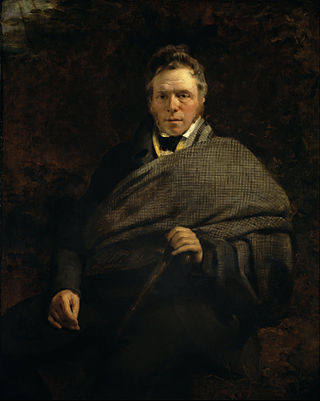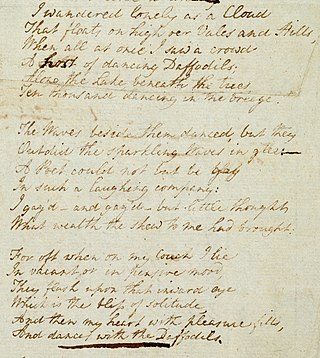
William Wordsworth was an English Romantic poet who, with Samuel Taylor Coleridge, helped to launch the Romantic Age in English literature with their joint publication Lyrical Ballads (1798).

The Yarrow Water is a river in the Borders in the south east of Scotland. It is a tributary of the Ettrick Water and renowned for its high quality trout and salmon fishing. The name "Yarrow" may derive from the Celtic word garw meaning "rough" or possibly share a derivation with the English name "Jarrow".

James Hogg was a Scottish poet, novelist and essayist who wrote in both Scots and English. As a young man he worked as a shepherd and farmhand, and was largely self-educated through reading. He was a friend of many of the great writers of his day, including Sir Walter Scott, of whom he later wrote an unauthorised biography. He became widely known as the "Ettrick Shepherd", a nickname under which some of his works were published, and the character name he was given in the widely read series Noctes Ambrosianae, published in Blackwood's Magazine. He is best known today for his novel The Private Memoirs and Confessions of a Justified Sinner. His other works include the long poem The Queen's Wake (1813), his collection of songs Jacobite Relics (1819), and his two novels The Three Perils of Man (1822), and The Three Perils of Woman (1823).

"I Wandered Lonely as a Cloud" is a lyric poem by William Wordsworth. It is one of his most popular, and was inspired by a forest encounter on 15 April 1802 that included himself, his younger sister Dorothy and a "long belt" of daffodils. Written in 1804, it was first published in 1807 in Poems, in Two Volumes, and as a revision in 1815.
Nationality words link to articles with information on the nation's poetry or literature.

"Ode: Intimations of Immortality from Recollections of Early Childhood" is a poem by William Wordsworth, completed in 1804 and published in Poems, in Two Volumes (1807). The poem was completed in two parts, with the first four stanzas written among a series of poems composed in 1802 about childhood. The first part of the poem was completed on 27 March 1802 and a copy was provided to Wordsworth's friend and fellow poet, Samuel Taylor Coleridge, who responded with his own poem, "Dejection: An Ode", in April. The fourth stanza of the ode ends with a question, and Wordsworth was finally able to answer it with seven additional stanzas completed in early 1804. It was first printed as "Ode" in 1807, and it was not until 1815 that it was edited and reworked to the version that is currently known, "Ode: Intimations of Immortality".

The Lucy poems are a series of five poems composed by the English Romantic poet William Wordsworth (1770–1850) between 1798 and 1801. All but one were first published during 1800 in the second edition of Lyrical Ballads, a collaboration between Wordsworth and Samuel Taylor Coleridge that was both Wordsworth's first major publication and a milestone in the early English Romantic movement. In the series, Wordsworth sought to write unaffected English verse infused with abstract ideals of beauty, nature, love, longing and death.
William Wordsworth was an English Romantic poet who, with Samuel Taylor Coleridge, helped launch the Romantic Age in English literature with their 1798 joint publication, Lyrical Ballads. His early years were dominated by his experience of the countryside around the Lake District and the English moors. Dorothy Wordsworth, his sister, served as his early companion until their mother's death and their separation when he was sent to school.
The "Matthew" poems are a series of poems, composed by the English Romantic poet William Wordsworth, that describe the character Matthew in Wordsworth's poetry.
"We are Seven" is a poem written by William Wordsworth and published in his Lyrical Ballads. It describes a discussion between an adult poetic speaker and a "little cottage girl" about the number of brothers and sisters who dwell with her. The poem turns on the question of whether to account two dead siblings as part of the family.
"Lucy Gray" is a poem written by William Wordsworth in 1799 and published in his Lyrical Ballads. It describes the death of a young girl named Lucy Gray, who went out one evening into a storm.

"I travelled among unknown men" is a love poem completed in April 1801 by the English poet William Wordsworth and originally intended for the Lyrical Ballads anthology, but it was first published in Poems, in Two Volumes in 1807. The third poem of Wordsworth's "Lucy series", "I travelled..." was composed after the poet had spent time living in Germany in 1798. Due to acute homesickness, the lyrics promise that once returned to England, he will never live abroad again. The poet states he now loves England "more and more". Wordsworth realizes that he did not know how much he loved England until he lived abroad and uses this insight as an analogy to understand his unrequited feelings for his beloved, Lucy.
"A slumber did my spirit seal" is a poem written by William Wordsworth in 1798 and published in the 1800 edition of Lyrical Ballads. It is usually included as one of his The Lucy poems, although it is the only poem of the series not to mention her name. The poem is a mere eight lines long; two "stanzas."

Poems, in Two Volumes is a collection of poetry by English Romantic poet William Wordsworth, published in 1807.

"The Sparrows Nest" is a lyric poem written by William Wordsworth at Town End, Grasmere, in 1801. It was first published in the collection Poems in Two Volumes in 1807.

"To a Butterfly" is a lyric poem written by William Wordsworth at Town End, Grasmere, in 1802. It was first published in the collection Poems, in Two Volumes in 1807.

"Poor Susan" is a lyric poem by William Wordsworth composed at Alfoxden in 1797. It was first published in the collection Lyrical Ballads in 1798. It is written in anapestic tetrameter.

Peter Bell: A Tale in Verse is a long narrative poem by William Wordsworth, written in 1798, but not published until 1819.

The White Doe of Rylstone; or, The Fate of the Nortons is a long narrative poem by William Wordsworth, written initially in 1807–08, but not finally revised and published until 1815. It is set during the Rising of the North in 1569 and combines historical and legendary subject-matter. It has attracted praise from some critics, but has never been one of Wordsworth's more popular poems.

Allan Bank is a grade II listed two-storey villa standing on high ground slightly to the west of Grasmere village in the heart of the Lake District. It is best known for being from 1808 to 1811 the home of William Wordsworth, but it was also occupied at various times by Dorothy Wordsworth, Dora Wordsworth, Thomas De Quincey, Samuel Taylor Coleridge, Thomas Arnold, Matthew Arnold and Canon Hardwicke Rawnsley. It is now owned by the National Trust and is open to the public.












